From puppy yoga to delicious, affordable eats, discover wellness escapes in Hamilton as the semester winds down and exams approach
As the end of the semester approaches and stress levels rise, it's important to take a step back and recharge. The City of Hamilton features a variety of relaxing spots that can help you break free from the hectic school bubble.
Whether you’re looking for physical activity, creative expression or simply a peaceful escape, the city has something for everyone. Here are some suggestions to help you unwind as the semester comes to a close.
Unwind with a one-of-a-kind experience at Studio 35’s weekly puppy yoga classes. By booking in advance on their website for $50 per person, you’ll get a one-hour session with puppies roaming freely around the room. After 35 minutes of yoga, enjoy 25 minutes of cuddling, playing and snapping pictures with the puppies. As the class wraps up, guests are offered an ice cream treat.
Treat yourself to a rejuvenating spa experience at Joie Day Spa, where you can indulge in services ranging from massage therapy to facials. While the services are on the pricier end for students compared to other activities, the experience could be worth it for a self-care day. You can book your appointment in advance through their website or by phone to ensure a relaxing and personalized visit.
Tap into your creativity at the Art Gallery of Hamilton’s monthly paint nights and open studio events. These free, drop-in sessions offer a space to explore your artistic side with plenty of supplies and guidance from talented artist educators. Whether you’re creating something new or seeking inspiration, it’s a welcoming environment to express yourself.
Two programs you can check out are QUARTZ: Queer Art Hang and the Youth Arts Collective Drop-in Open Studio.
For a taste of authentic Jamaican cuisine, head to Ellis Kitchen. As a Jamaican myself, I know how challenging it can be to find good Jamaican restaurants without having to leave Hamilton. After trying several places in the city, I can vouch for the flavourful, comforting dishes they serve, making it the perfect spot for anyone craving home-style Jamaican food.
The variety of food offered is great as well—from jerk chicken to patties to mackerel, this spot offers a genuine taste of the island.
If you’re craving birria tacos, look no further than Amigos Tex-Mex. This spot serves up tasty Tex-Mex dishes, including birria tacos, with vegetarian and vegan options available. Open late until 2 a.m. on weekends, it’s a great place to satisfy your cravings and enjoy flavourful food and great service.
Taking a break from the hustle and bustle of the school season is essential for maintaining balance and well-being. Whether you’re looking to unwind with some puppy yoga, indulge in a spa day or enjoy a delicious meal, these spots in Hamilton offer the perfect escape to recharge.
So, take some time for yourself and explore local gems to destress and refresh before exams begin.
Fourth-year McMaster student campaigning to be Member of Provincial Parliament for nearby riding in upcoming provincial by-election
Joshua Bell, a fourth-year political science student at McMaster University, is running to be the next member of provincial parliament for Flamborough-Glanbrook in the upcoming provincial by-election on Feb. 27, 2025. Bell, the Ontario Liberal Party candidate for the riding just outside of Hamilton, is campaigning on issues of healthcare, education and affordability, running against incumbent PC MPP Donna Skelly.
Bell, who has lived in the area his entire life, said his decision to run stemmed from long-standing community involvement and concerns over public service funding cuts.
“We have teachers and schools that are not being looked after and we have funding being cut left and right from our social and public services . . . We need schools to be adequately funded. Heating should be working during the winter and ACs during the summer and in some of our schools that’s not the case,” said Bell.
We need schools to be adequately funded. Heating should be working during the winter and ACs during the summer and in some of our schools that’s not the case.
Joshua Bell, Fourth-Year Political Science Student
McMaster University
He also emphasized addressing challenges with the healthcare system, including emergency room closures and staffing shortages, as key issues his campaign is focused on.
Bell has been involved in mental health and wellness advocacy and supported the implementation of Canada’s national 988 suicide crisis helpline, which was launched in November 2023. He believes there is a lack of adequate healthcare services in the province.
“ERs should not be closing or having to reduce their hours in order to just deliver care because the number of nurses is so short . . . Our healthcare system isn’t keeping pace with the needs of the province, especially for our aging population,” said Bell.
ERs should not be closing or having to reduce their hours in order to just deliver care because the number of nurses is so short . . . Our healthcare system isn’t keeping pace with the needs of the province, especially for our aging population.
Joshua Bell, Fourth-Year Political Science Student
McMaster University
Bell said that, as a McMaster student, he has engaged with student leaders and organizations but has primarily focused his efforts on broader community initiatives.
“I did meet in an official capacity with MSU presidents and VPs over the last number of years . . . I had met with all three candidates in the recent MSU presidential election and had discussions about health and wellness, the economy and housing,” said Bell.
Bell outlined his support for reinstating policies aimed at providing greater financial support for students, including delaying Ontario Student Assistance Program repayments until graduates earn a minimum of $50,000 annually.
Bell acknowledged that his candidacy as a student is unusual but said it should not deter voter engagement.
“I’ve always been active in some kind of volunteer role within our community . . . If you really care about something and really want change, you’re willing to make the time, meet with the people in your community that are being directly affected and work toward solutions,” said Bell.
Bell emphasized that he believes that it is important for students to vote in elections.
“Student engagement is really important, just like our middle-aged and senior populations . . . It’s important to come out and have your voices heard, talk to your candidates, talk to your MPPs and MPs,” said Bell.
With his graduation approaching, Bell said his primary focus remains on the campaign and serving his community.
“My focus has been and will continue to be on my community,” he said.
Advanced polling will run until Feb. 22, with the election set for Feb. 27. More information on voter registration and polling locations will be available through Elections Ontario.
With a two-person cast and minimal set, Constellations demonstrates the charm of a good story
Hamilton Theatre Project’s production of Constellations opened on Feb. 6, 2025 at the Lyons Family Studio, located in L. R. Wilson Hall. This is HTP’s second run of the show, which they performed at The Staircase in June 2024.
Constellations, written by Nick Payne, follows the relationship of Marianne and Roland through different universes, mapping out multiple possible endings and beginnings. Amber Mills, the artistic producer of HTP, discussed how the play's themes stood out to her. “I feel like it’s a really beautiful look at how we spend our time and why it matters and the choices we make and how they impact the way our lives unfold,” said Mills, “That concept or idea of “what if?” and exploring the multiverse from a love perspective is really appealing to me.”
I feel like it’s a really beautiful look at how we spend our time and why it matters and the choices we make and how they impact the way our lives unfold.
Amber Mills, Artistic Producer
Hamilton Theatre Project
Mills also acts in the show, playing Marianne, alongside Colin Palangio, who plays Roland. “In my mind, as an actor it’s super appealing to do a project like this that’s small. It’s really just about storytelling and just about the relationship and not really about any production value or other things,” said Mills.
For this production, the theatre was configured “in the round” with approximately 80 seats, creating an immersive experience. “I can’t really imagine this play not [in the round]. It feels like a play that kind of calls to have people all around. [A traditional stage] can feel quite limiting, you can only play in one direction. So this feels like it gives you a lot of freedom,” said Mills.
The stage was set with two wooden benches, a chair, and some small boxes. Throughout the show, the benches are reconfigured to create various settings, and a couple of props are taken out from the boxes. Colin Palangio, who plays Roland, explained how they decided on the set pieces. “We stuck with the sparse, very little going on, because really it’s about the couple. They’re traversing different universes so much, so that would be way too much prop and set,” said Palangio.
Without set changes, the multiverse is only indicated via alternate versions of the “same” scene. This structure presents a fun challenge for Mills and Palangio, who are responsible for conveying a new scene while repeating identical or similar dialogue. “It’s definitely an actor’s pleasure to do something like this because you really get to play,” said Palangio, “It reminds me of going back to not seeing the sunlight in theatre school and just trying a scene over and over. And I think what’s cool is that this show really sort of requires you to do that.”
As the only cast members, Mills and Palangio are wholly responsible for telling the story. “I don’t feel like I can hide, it really asks a lot of you as an actor,” said Mills. “There’s just the dialogue and the two people and trusting your scene partner because you’re only really as good as the people you share the stage with,” said Palangio.
You're only really as good as the people you share the stage with.
Colin Palangio, Actor
Hamilton Theatre Project
Both actors remain onstage throughout the entire 90-minute play and are only unlit during brief voice-over transition scenes and minor set adjustments. The play is impressively fast paced, often switching between universes without warning and requiring the actors to change their expressions, body language and tone of voice within a few seconds. “It’s kind of unrelenting, you don’t really get a breather per se. You go on this ride and you just stay on it for 90 minutes,” said Mills.
Mills shared that HTP was invited to bring the show to campus by the arts operations, resources and production department of McMaster’s school of the arts “[They were] excited about bringing something that was sort of from Hamilton. A Hamilton-based project, something semi-professional that the students could come and see, . . . that wasn’t the same type of theatre that they might see anywhere else in town,” said Mills.
Constellations is on until Feb. 15, 2025. To view the full list of showtimes or purchase a ticket, you can visit the showpass page. Current McMaster students can use the promotional code MAC50 at checkout to receive a 50 per cent discount. To keep up with HTP and their future projects, you can find them on Instagram or Facebook.
FCC brings students together to learn and share accessible recipes in a hands-on cooking experience
The McMaster Students Union's Food Collective Centre hosted its January cook-along event on Jan. 29, 2025, at The Hub. This event is part of a monthly series designed to promote food literacy, build community and demonstrate how meal preparation for students can be accessible.
This month's cook-along, held in collaboration with Maccess, emphasized making cooking more accessible for people with disabilities. During the two-hour session, participants prepared a coconut chickpea curry, chapati flatbread and a cucumber yogurt salad.
Christine Lin and Harry Li, the FCC's Community Kitchen coordinators, explained to the Silhouette that the event is open to all members of the McMaster community, including undergraduates, graduate students and staff.
"We call it a workshop, but we're really just cooking together. It's a collaborative opportunity to learn from each other, whether participants are experienced or just starting out," said Lin.
We call it a workshop, but we're really just cooking together. It's a collaborative opportunity to learn from each other, whether participants are experienced or just starting out.
Christine Lin, Community Kitchen Coordinator
Food Collective Centre
The recipes chosen for the workshops aim to reflect the FCC's core goals for diversity and accessibility. Each month, the recipes are selected so as to use seasonal ingredients an array of dishes from diverse backgrounds.
Recent events featured dishes like vegetable stir fry and tacos, showcasing a medley of global cuisines. Lin and Li highlighted the effort to ensure that recipes accommodate dietary restrictions, with vegetarian modifications always available.
In addition to cooking skills, participants gained practical knowledge such as meal planning, budgeting and food safety. According to Lin, the workshops also address food literacy, teaching participants how to find ingredients and prepare nutritious meals.
The cook-along initiative aligns with broader efforts to address food insecurity on campus, including the upcoming Food Accessibility Initiative referendum. The referendum proposes increasing the MSU organizational fee by $6.50 to fund the Soup & Bread Initiative, which would provide free soup and bread to students throughout the academic year.
Lin and Li expressed their support for the referendum's proposals, noting that these measures would help relieve the hunger of many students. However, they also emphasized that addressing food insecurity requires a more comprehensive and long-term approach that goes beyond immediate relief provided by such programs.
"Food insecurity is a complex issue. It's great that people will be able to have a free lunch every day, but what about the rest of the day? Are they able to cook by themselves at home? . . . We have to think more holistically," said Lin.
Food insecurity is a complex issue. It's great that people will be able to have a free lunch everyday, but what about the rest of the day? Are they able to cook by themselves at home?
Christine Lin, Community Kitchen Coordinator
Food Collective Centre
Lin and Li noted the importance of increasing the variety and accessibility of nutritious food options on campus. They emphasized that it is not just about providing meals but also about ensuring that students have access to fresh, affordable ingredients that empower them to cook at home.
They also explained how food insecurity differs among diverse groups of students. They suggested that graduate students, for example, can struggle to afford nutritious ingredients. Meanwhile, first-year students may not face the same immediate need to cook due to living in residence but could still benefit from learning basic cooking skills to prepare for future independence.
For students unable to attend the cook-along, Lin and Li also mentioned that the FCC is developing a cookbook featuring workshop recipes. The cookbook will include a variety of cultural recipes contributed by volunteers, aligning with the FCC's focus on representing McMaster's diverse campus community.
Looking ahead, the FCC has plans for future cook-alongs, including a February session in collaboration with the McMaster Community Garden and the McMaster Nutrition Club.
A kinder and more respectful world starts with tough conversations, and a few whiskers
By: Dawn McKee, Arts and Culture Contributor
From 12:00 p.m. to 3:00 p.m. on Jan. 13, 2025, Sexual Assault Centre Hamilton and McMaster’s Sexual Violence Prevention and Response Office hosted Cats Against Catcalling, a joint event in the McMaster University Student Centre.
This event tackled the issue of street harassment while offering students the chance to engage with adoptable cats from the Hamilton/Burlington SPCA. The event used a unique approach to address a serious topic, combining education with stress relief to facilitate meaningful conversations about catcalling and its impact.
The event organizers—Miranda Jurilj, Jessica Sondhi-Cooke, Rinsy Gandhi and Nada Nassar—emphasized that catcalling is a form of sexual violence, not a harmless compliment. Sondhi-Cooke explained that Canadian statistics show over a quarter of women on post-secondary campuses experience harassment, along with six percent of men. Marginalized groups, including non-binary individuals, are disproportionately affected.
Cats were a creative way to draw in people to attend while creating a welcoming environment for discussions about sensitive topics. Before interacting with the cats, students attended a presentation on bystander intervention, ensuring that they left with both knowledge and an engaging experience.
“We want students to understand that harassment is never acceptable and that they can take steps to stop it," said Sondhi-Cooke.
We want students to understand that harassment is never acceptable and that they can take steps to stop it.
Jessica Sondhi-Cooke, Peer Educator
McMaster SVPRO
The HBSPCA’s involvement also highlighted animal welfare, adding another layer to the event’s message of compassion. “We love animals, and working with the SPCA allowed us to align our goal of providing care for both people and animals” shared Jurilj.
Nassar explained that the event focused on teaching the "five Ds" of bystander intervention: direct, distract, document, delegate and delay. At the event, organizers explained how students could use these strategies to intervene safely when witnessing harassment, tailoring their actions to their comfort levels and circumstances.
“Whether it’s distracting the harasser, recording the incident, or supporting the person being targeted afterward, there’s always something you can do to help,” said Jurilj.
Whether it’s distracting the harasser, recording the incident, or supporting the person being targeted afterward, there’s always something you can do to help.
Miranda Jurilj, Public Education Coordinator
SACHA
Street harassment resonates with students, many of whom are away from home for the first time and navigating unfamiliar environments. The event emphasized that everyone plays a role in creating a safe campus culture and showed survivors that they are not alone.
“Ending harassment is possible when we work together. Every action, no matter how small, can make a difference,” said Gandhi.
Peer-led education played a significant role, with student presenters breaking down barriers to participation. Stickers and other take-home materials encouraged participants to continue the conversation beyond the event.
By combining education with engagement, Cats Against Catcalling demonstrated that small actions can drive meaningful cultural change. The event left students with tools to address harassment and a sense of shared responsibility for fostering respect and safety on campus.
City of Hamilton and United Way Halton & Hamilton launch Toys for Tickets, enabling residents to pay parking fines through toy donations
From Dec. 2 to 6, 2024, Hamilton residents have the chance to transform their parking fines into holiday cheer through the Toys for Tickets pilot program. During this period, individuals who have been issued parking tickets can pay their fines by donating a new, unwrapped toy of equal or greater value than their ticket.
The donated toys will be distributed through United Way Halton & Hamilton as part of its Holiday Helping Hand program. Kristen Jacob, vice president of marketing and communications for the organization, highlighted that the program aligns with its mission to support community well-being through initiatives targeting youth, poverty and mental health.
"[Toys for Tickets] is a program that offers meaningful ways for the community to engage with United Way and support their community . . . It is critical for our community to receive some of these toys so that children have a joyous holiday season," said Jacob.
It is critical for our community to receive some of these toys so that children have a joyous holiday season.
Kristen Jacob, Vice President of Marketing and Communications
United Way Halton & Hamilton
United Way Halton & Hamilton supported over 220,500 individuals and families across 124 social service programs last year. Jacob highlighted that one in six people in Hamilton access their services and the demand continues to increase.
"[The] thing is that when we ask family members what their wish lists are for the year or the program, they come back with things that are a little shocking to us," Jacob explained, describing that wish lists included gift cards for gas, basic hygiene products and food.
Jacob also highlighted the program's unique impact. "It gives an extra layer of compassion from people who already need to pay that fine, knowing that the toys being donated through this program are going to families who desperately need them this year . . . [the toys] gives them something to look forward to," said Jacob.
It gives an extra layer of compassion from people who already need to pay that fine, knowing that the toys being donated through this program are going to families who desperately need them this year.
Kristen Jacob, Vice President of Marketing and Communications
United Way Halton & Hamilton
In addition to Toys for Tickets, United Way encourages the community to explore other ways to give back. Options include online donations, monthly giving, or volunteering.
Looking ahead, United Way Halton & Hamilton is preparing for its Sleepless in Our Cities program in February 2025. This event raises awareness about poverty by inviting participants to spend a night in their vehicles to better understand the realities of homelessness.
The Hamilton Academy of Performing Arts highlights why this ballet remains central to the holiday season, year after year
The Nutcracker isn’t just a ballet—it's a timeless tradition, a cornerstone of the holiday season that continues to captivate audiences year after year. With its themes of imagination, connection, and transformation, it has a way of resonating across generations, drawing people into a world of wonder.
For over 23 years, the Hamilton Academy of Performing Arts has been connecting people through ballet. Dec. 6 and 7, 2024 marks their 10th annual rendition of The Nutcracker at the McIntyre Performing Arts Centre, blending classic elements with creative touches to create a memorable experience.
Melania Pawliw, co-founder and artistic director of the Hamilton Academy of Performing Arts, shared how for many families, The Nutcracker is a holiday tradition and a first step into the world of live theatre. “For young audiences, The Nutcracker is usually their first introduction to the ballet,” said Pawliw.
For young audiences, The Nutcracker is usually their first introduction to the ballet.
Melania Pawliw, Co-Founder and Artistic Director
Hamilton Academy of Performing Arts
Tchaikovsky’s iconic score and the enchanting story of Clara and her Nutcracker Prince invite audiences to dream, telling a tale that feels as fresh as it does familiar. Pawliw shared that while The Nutcracker is performed year-round in Europe, in North America it has become synonymous with the holiday season, embodying a sense of community and celebration. “[In Europe] it’s just a ballet like any other ballet.” said Pawliw.
What makes the Hamilton Academy’s production distinct is its ability to marry tradition with accessibility. “Any ballet we do, we stay close to the original storyline and choreography,” shared Pawliw, “We always adapt the choreography to add so many new parts, because it creates more opportunity for children to be in the production.”
Drawing inspiration from Vasily Vainonen’s original choreography, this rendition introduces fresh elements such as a live orchestra and choir, elevating the performance in new and exciting ways. “We always look for ways to expand the production.” explained Pawliw.
Community involvement is at the core of the Hamilton Academy’s approach. With over 100 roles available, dancers from Hamilton and surrounding areas audition to take part, including both young students and seasoned professionals. This mix of backgrounds creates a unique environment where children can gain experience that inspires personal and artistic growth.
Pawliw shared that the most rewarding part of her job is watching young dancers evolve from smaller roles to leading characters over time.
For those new to ballet, The Nutcracker presents a lively and immersive experience. “It’s a holiday celebration that brings people together,” said Pawliw. From the elegance of the Sugar Plum Fairy’s dance to the mesmerizing Waltz of the Snowflakes, every detail is designed to delight. The live orchestra brings Tchaikovsky’s score to life, surrounding the audience with the richness of his timeless music.
It's a holiday celebration that brings people together.
Melania Pawliw, Co-Founder and Artistic Director
Hamilton Academy of Performing Arts
As the Hamilton Academy of Performing Arts continues its annual tradition of bringing The Nutcracker to life, it reaffirms the arts’ power to connect and inspire. They have not only kept the tradition of The Nutcracker alive but have also expanded its impact, making the ballet a shared experience that connects people through the beauty of performance and the holiday spirit.
The Nutcracker invites everyone to celebrate the season’s joy together. Performances will take place on Dec. 6, 2024 at 7:30 p.m. and Dec. 7, 2024 at 2:00 p.m. and 7:30 p.m.. Don’t miss this classic holiday tradition!
Hamilton community members and students call for justice and accountability in wake of Erixon Kabera's death
On Nov. 14, 2024, over 400 people gathered outside Hamilton City Hall in the rain to honour the memory of Erixon Kabera. A well-known member of the Rwandan-Canadian community, Kabera was fatally shot by police two weeks ago.
The crowd, which included some McMaster students, marched from City Hall to the Hamilton Central Police Station, demanding transparency and accountability in the investigation of his death.
Kabera, 43, was fatally shot on Nov. 10, 2024, after an encounter with police. According to the Special Investigations Unit, which is responsible for investigating circumstances involving the police, officers responded to a call reporting a man at an apartment building with what appeared to be a handgun.
The Special Investigations Unit initially stated there was an "exchange of gunfire" during the incident but later clarified that Kabera did not fire a weapon. The Special Investigations Unit stated that two police officers discharged their firearms and that a replica gun was found at the scene.
Kabera's family has expressed outrage over the evolving narrative from authorities. "We find that reversal of crucial facts, a full day after telling the entire world otherwise and painting an image of violence for our very own, to be deeply outrageous and unnerving," expressed Kabera's family in a statement to The Public Record.
We find that reversal of crucial facts, a full day after telling the entire world otherwise and painting an image of violence for our very own, to be deeply outrageous and unnerving.
Erixon Kabera's family
The family described Kabera as a compassionate and honourable man who dedicated his life to his three sons, Garry Sean, Terry and Zack, aged 10, 13 and 17.
Hfsa Awan, a McMaster undergraduate student who attended the event, shared a reflection upon attending. “The memorial felt really empowering . . . I expected mourning, but instead, it was a powerful moment of people coming together and calling for justice,” said Awan.
Awan believes students can play a crucial role in raising awareness by fostering open dialogue and educating themselves on issues like police accountability. “Our privilege as students is to educate ourselves—that’s how we can contribute,” said Awan.
She also expressed feeling that the university should take a more active role in addressing the tragedy, noting that its proximity to campus makes it a deeply local issue. “Everyone is affected, and the university should be uplifting students who are mourning his death,” said Awan.
Kabera had lived in Canada for 20 years, building a life for his family as a resource officer with the Canada Revenue Agency and starting a small business. He was an advisor to the Rwandan Canadian Healing Centre for nearly a decade, contributing to community initiatives and supporting others.
During the vigil, speakers remembered Kabera's kindness and called attention to the Hamilton Police Service's disproportionate use of force against Black residents. The Rwandan Canadian Healing Centre issued a statement calling for "a full transparent investigation" into the circumstances of Kabera's death.
Kabera's close friend Andy Ganza, who had been on his way to visit Kabera the night of the incident, has started a GoFundMe campaign to support Kabera's family and cover funeral and legal expenses.
"Erixon dedicated his life to his family, faith and community, building a reputation as a compassionate, gentle and honourable man," said Kabera's family in their public statement. Community members continue to mourn his loss and demand answers about the events that led to his tragic death.
Erixon dedicated his life to his family, faith and community, building a reputation as a compassionate, gentle and honourable man.
Erixon Kabera's family
The Hamilton Bike Share community ride across Hamilton ended with a reveal of the new Hamilton Harbour accessible bike hub
This article is a part of the Silhouette Photo-Journalism series.
The Everyone Rides Initiative's most recent community bike ride took participants on a tour of the city's murals as a celebration of public art. The ride took place on the morning of Nov. 16, 2024, starting at Corktown Park and ending at Hamilton Harbour. There, the new Bayfront Park Adaptive Bike Hub was unveiled, set to begin operation in April of 2025.
The Everyone Rides Initiative is an equity program within the Hamilton Bike Share organization that aims to remove barriers to accessing cycling as a mode of transportation. Their new adaptive bike hub will be the second-ever of its kind in Hamilton, with the first located in Gage Park.
Paul Copcutt, a participant of the ride explained that he attended to deliberately appreciate the murals. "I think the cool thing about Hamilton is that there are so many murals that people don't even notice," said Copcutt. The following is a documentation of some of the murals found along the ride.
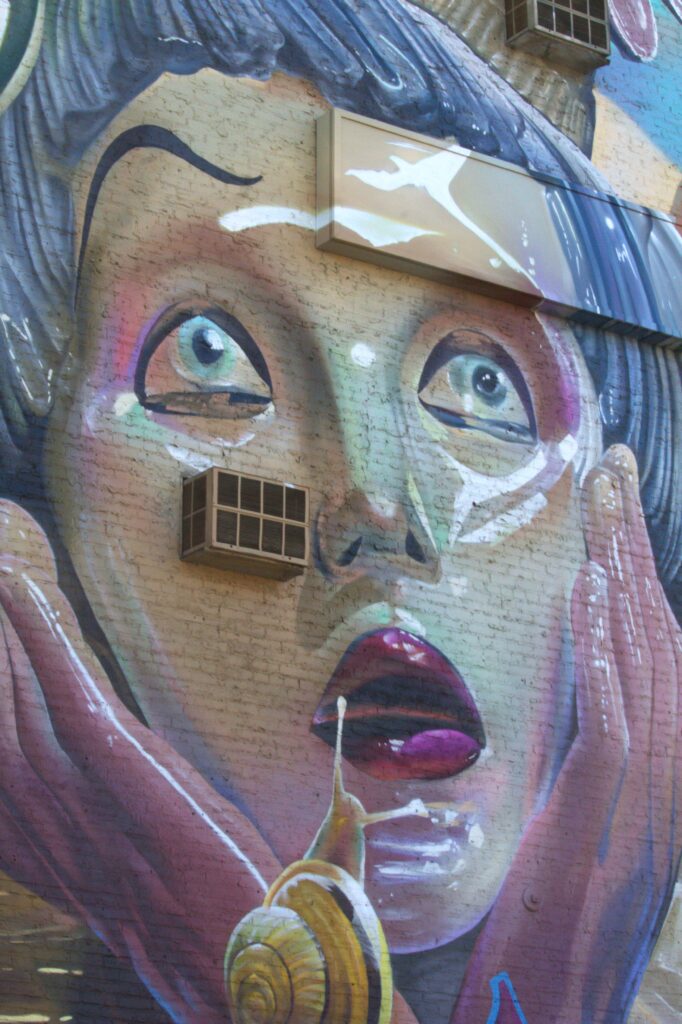
At the corner of James Street North and Wilson Street, this breathtaking mural was the crowd favorite for the mural ride cyclists. Created by artists Alexander Bacon, Heiro, KWest and TukeOne.
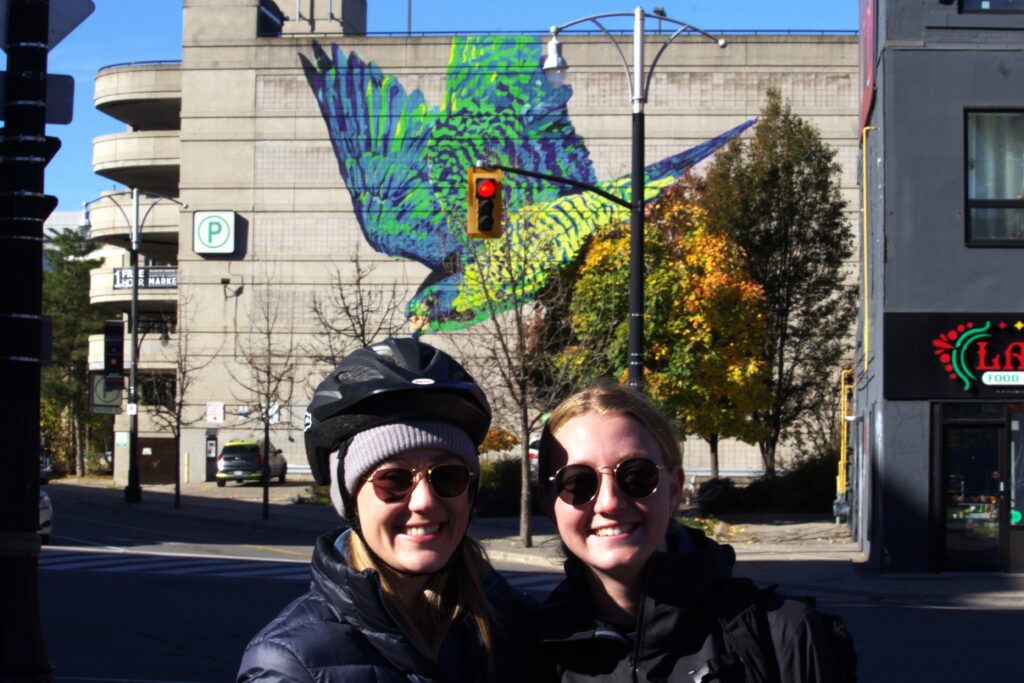
Directly opposite from the pervious mural, a peregrine falcon, Hamilton's unofficial city bird can be seen painted at York Street. Pictured here are Abbie Little (left), Co-Chair for Cycle Hamilton and Olivia MacAskill (right), Community Engagement Manager at Hamilton Bike Share.
The artist Scott MacDonald, painted the outline and set up a QR code where the community could fill in the colours in any way they desired. He then picked his favourite submissions and asked the community to vote on which should be painted, resulting in the gorgeous green and blue bird.
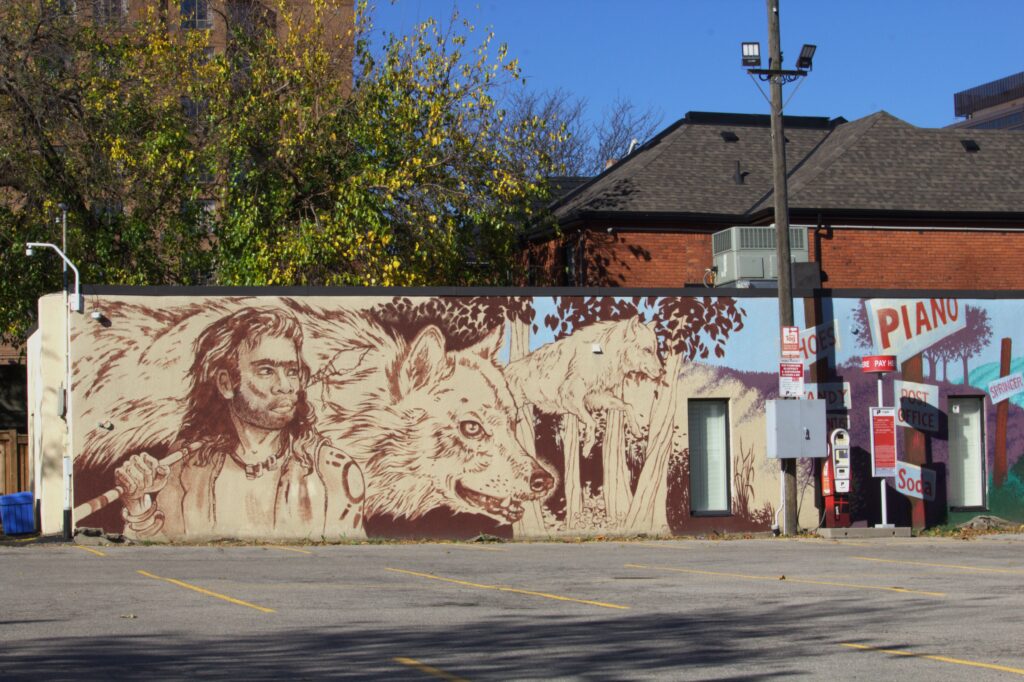
This mural can be found at the corner of Walnut Street and Jackson Street tucked away in a parking lot, artist unknown.
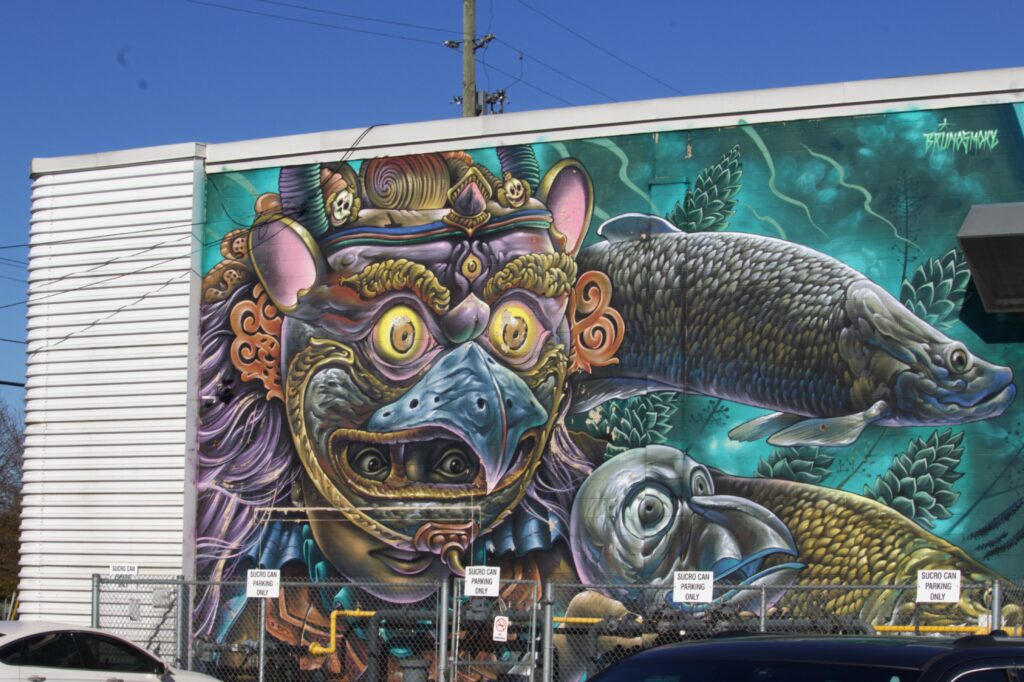
This mural brought more aquatic themes to the ride as it drew closer to the harbour. Also tucked away in a parking lot, this wonderful mural was an extra stop for the riders as they approached the accessible bike hub
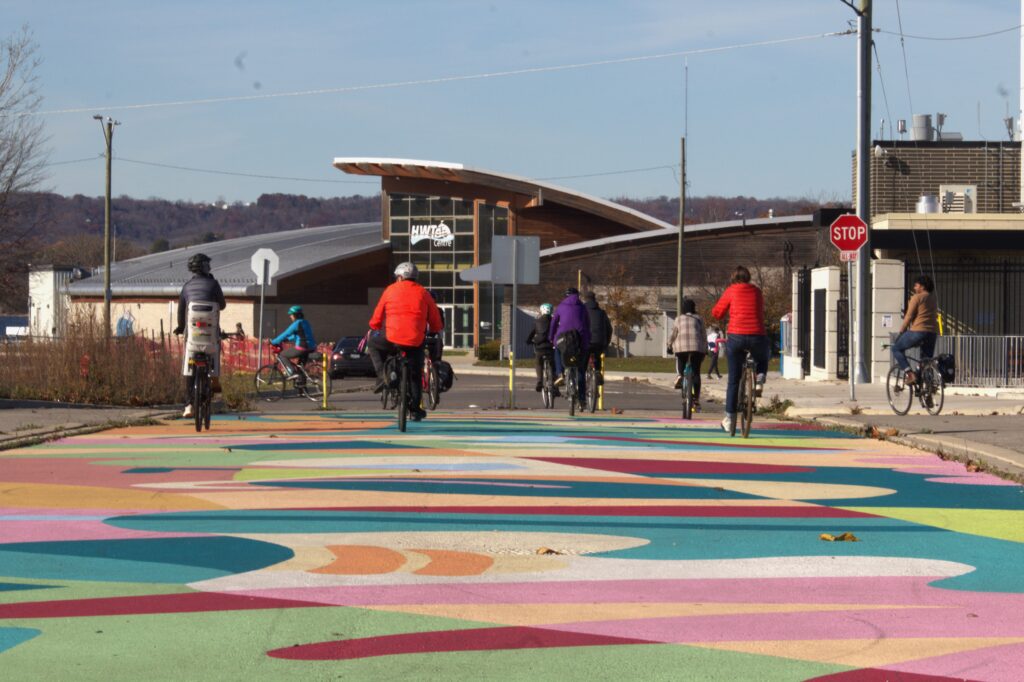
As the ride came to a close, this mural along the waterfront made for a scenic entrance into the harbour. Painted by Clear Eyes Collective.
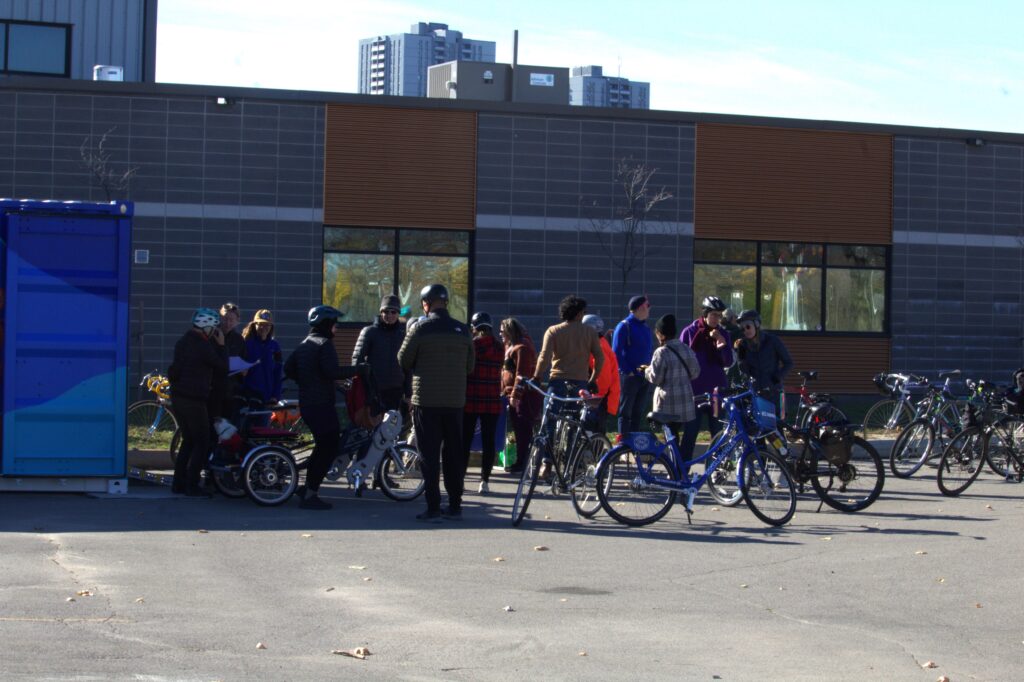
Riders then collected at the harbour to try the new accessible bikes. Coffee and donuts were provided for the riders to celebrate the unveiling of the hub and discuss the murals.
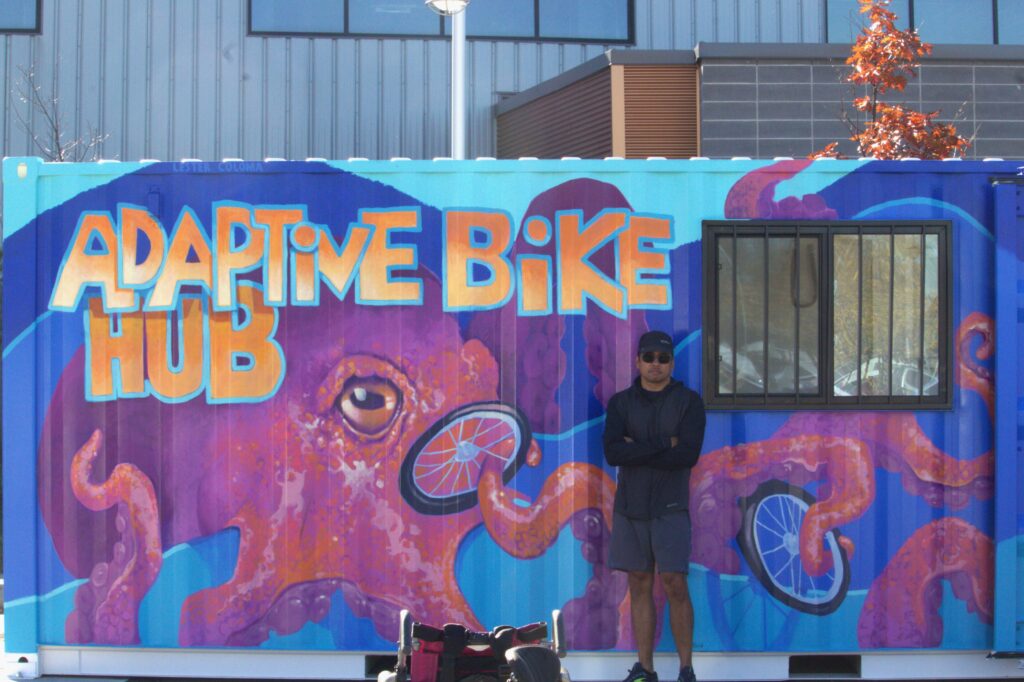
Lester Coloma (pictured here) is the artist behind mural at the accessible bike hub at Hamilton Harbour. He said that painting this mural was a challenge due to the the weather but he was inspired by the nearby water.
"The whole idea for the octopus was for the theme of the water by the harbour," said Coloma. He is no stranger to murals and his work can be found across the city, including one depicting construction along Hess Street and between Barton and Cannon Street.

A recumbent bicycle (pictured here) is one of many accessible bikes offered by the hub. Others include tricycles, e-assist, dual and side-by-side tandem, hand cycle bicycles and recumbent bicycles (pictured here).
The variation allows for all to be able to feel the joy of cycling, part of the mission of the Everyone Rides Initiative. The hub will also be equipped with an array of modifications that can be added to the bikes, such as allowing a rider to reach the pedals more easily.
Riding an adaptive bike from the hub will be free and there will be staff at the hub to help riders have the best experience. Bikes can be rented for one hour at a time in order to ensure that each rider has the equipment that they need to enjoy cycling.
The Everyone Rides Initiative hosts many community rides that explore public art and interesting locations throughout Hamilton. Details are available on their website for you to see upcoming events and all that the city has to offer.
This not-for-profit organization is creating an accessible platform that celebrates local talent and reinvents fashion culture in the city
By: Zoha Alvi, Arts and Culture Contributor
Hamilton may be known for its industrial history but it’s quickly becoming a cultural destination—and fashion is at the forefront of this transformation. Hamilton Fashion Week and its events, such as the Runway Project, are providing a platform for local designers and redefining what it means to be an emerging fashion hotspot.
Krystal and Ken Biehler founded Hamilton Fashion Week in 2014 to celebrate and elevate local talent. “We’ve seen a big resurgence in the art and music crowd, but there was nothing for the fashion community. We realized there were very few platforms in Canada, let alone Hamilton,” said Ken.
The Biehlers aim to foster a sense of community that sets Hamilton’s fashion scene apart—a place where creatives can learn and grow together. “In Toronto, the vibe can feel competitive and unprofessional in a lot of ways. We want to create a positive, uplifting sort of environment for everyone to succeed,” Ken suggested. Krystal noted that the local fashion community has developed its own identity rooted in collaboration and creativity rather than rivalry.
We want to create a positive, uplifting sort of environment for everyone to succeed.
Ken Biehler, co-founder
Hamilton Fashion Week
One example of Hamilton Fashion Week’s impact is the Hamilton Runway Project, an intimate event designed to make fashion accessible for emerging designers and encourage young talent. The “Falling for Fashion” themed event took place on Oct. 17, 2024, inviting designers to showcase autumn-inspired outfits that highlighted their connection to the craft. Participants presented a single themed look instead of a traditional collection, minimizing the cost and time commitment required.
Audience members were able to engage with designers and vote for their favourite designs, while a panel of industry experts selected two winners: Bobby Raffin and Michelle Brisson.
According to Krystal, one of the main goals for Hamilton Fashion Week is to set new standards creating a reliable, professional and skill-building space for models, photographers and makeup artists. “If people aren’t getting paid, it’s kind of like putting on an art project. But in order to advance things, there needs to be that professional sort of platform to be able to grow,” added Ken.
The Biehlers explained how this mindset has led to Hamilton-based talent standing out, to the point where Hamilton locals are now known for their skills across Ontario and beyond.
For the Biehlers, Hamilton Fashion Week is about more than just putting on a show—it’s about creating a space where community meets creativity. “When we started, if you asked a group of people if they’d ever been to a fashion show, the answer was almost always no. But now I feel like we’ve made fashion part of the local culture and we hope to grow that,” said Ken.
They emphasized the importance of taking initiative, particularly for young, aspiring designers without access to big-city resources. “Every young person should have an opportunity to carry on in any career that they want, with successes and resources available to them within their grasp. Just do it, you never know what’s going to take off," said Ken.
Every young person should have an opportunity to carry on in any career that they want, with successes and resources available to them within their grasp.
Ken Biehler, co-founder
Hamilton Fashion week
Krystal also encouraged young designers to get connected and showcase their work on social media, saying, “You can get started with literally nothing. Don’t be afraid, just do it and have fun with it!” Beyond creativity, Ken highlighted the importance of a business mindset, urging designers to also consider marketability and target audiences.
As Hamilton Fashion Week continues to grow, so does the city’s fashion community, gaining momentum as a creative capital with each new event. Looking ahead, their 11th annual gala show is set for Feb. 15, 2025. For Krystal and Ken, this journey is just beginning, as they are focused on expanding Hamilton Fashion Week and supporting the next generation of creatives who will define Hamilton’s unique creative future in fashion.